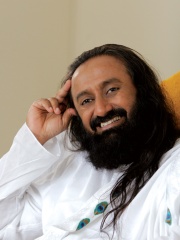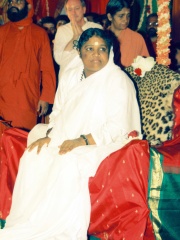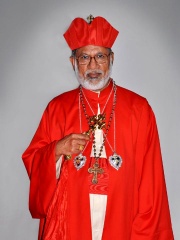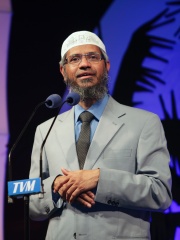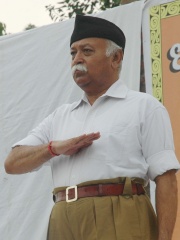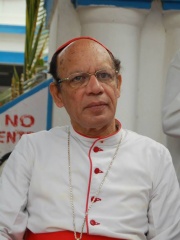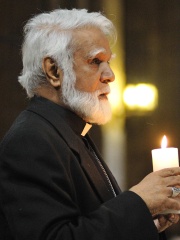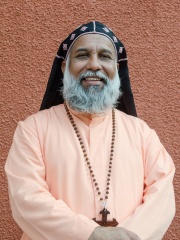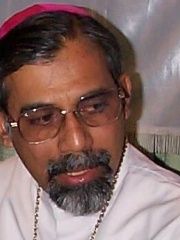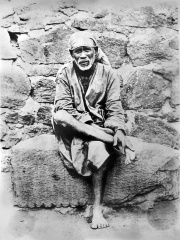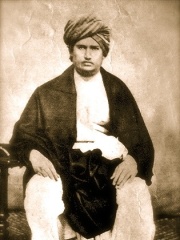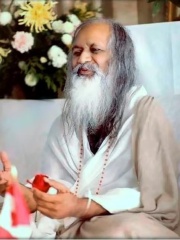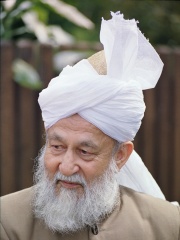

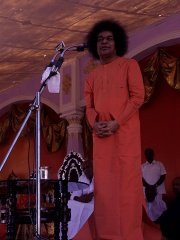
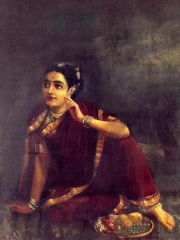
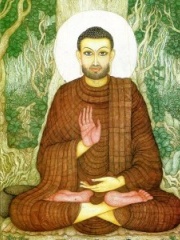
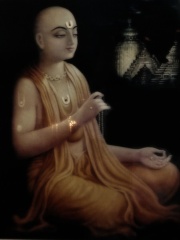
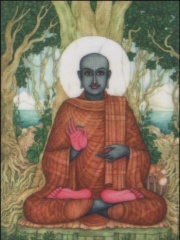
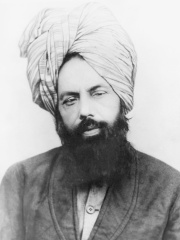
The Most Famous
RELIGIOUS FIGURES from India
This page contains a list of the greatest Indian Religious Figures. The pantheon dataset contains 3,187 Religious Figures, 63 of which were born in India. This makes India the birth place of the 10th most number of Religious Figures behind Egypt, and Saudi Arabia.
Top 10
The following people are considered by Pantheon to be the top 10 most legendary Indian Religious Figures of all time. This list of famous Indian Religious Figures is sorted by HPI (Historical Popularity Index), a metric that aggregates information on a biography’s online popularity. Visit the rankings page to view the entire list of Indian Religious Figures.

1. Mahavira (-599 - -527)
With an HPI of 75.34, Mahavira is the most famous Indian Religious Figure. His biography has been translated into 77 different languages on wikipedia.
Mahavira (Devanagari: महावीर, Mahāvīra), also known as Vardhamana (Devanagari: वर्धमान, Vardhamāna), was the 24th Tirthankara (supreme preacher) of Jainism. He was the spiritual successor of the 23rd Tirthankara Parshvanatha. Mahavira was born in the early 6th century BCE into a royal Jain family of ancient India. His mother's name was Trishala and his father's name was Siddhartha. They were lay devotees of Parshvanatha. Mahavira abandoned all worldly possessions at the age of about 30 and left home in pursuit of spiritual awakening, becoming an ascetic. Mahavira practiced intense meditation and severe austerities for twelve and a half years, after which he attained Kevala Jnana (omniscience). He preached for 30 years and attained moksha (liberation) in the 6th century BCE, although the year varies by sect. Mahavira taught that observance of the vows of ahimsa (non-violence), satya (truth), asteya (non-stealing), brahmacharya (chastity), and aparigraha (non-attachment) are necessary for spiritual liberation. He taught the principles of Anekantavada (many-sided reality): syadvada and nayavada. Mahavira's teachings were compiled by Indrabhuti Gautama (his chief disciple) as the Jain Agamas. The texts, transmitted orally by Jain monks, are believed to have been largely lost by about the 1st century CE. Mahavira is usually depicted in a sitting or standing meditative posture, with the symbol of a lion beneath him. His earliest iconography is from archaeological sites in the North Indian city of Mathura, and is dated from between the 1st century BCE and the 2nd century CE. His birth is celebrated as Mahavir Janma Kalyanak and his nirvana (salvation) and also his first shishya of Gautama Swami is observed by Jains as Diwali. Historically, Mahavira, who revived and preached Jainism in ancient India, was an older contemporary of Gautama Buddha. Jains celebrate Mahavir Janma Kalyanak every year on the 13th day of the Indian Calendar month of Chaitra.

2. Ānanda (-600 - -500)
With an HPI of 74.61, Ānanda is the 2nd most famous Indian Religious Figure. His biography has been translated into 49 different languages.
Ānanda (Pali and Sanskrit: आनन्द; 5th–4th century BCE) was the primary attendant of the Buddha and one of his ten principal disciples. Among the Buddha's many disciples, Ānanda stood out for having the best memory. Most of the texts of the early Buddhist Sutta-Piṭaka (Pali: सुत्त पिटक; Sanskrit: सूत्र-पिटक, Sūtra-Piṭaka) are attributed to his recollection of the Buddha's teachings during the First Buddhist Council. For that reason, he is known as the Treasurer of the Dhamma, with Dhamma (Sanskrit: धर्म, dharma) referring to the Buddha's teaching. In Early Buddhist Texts, Ānanda was the first cousin of the Buddha. Although the early texts do not agree on many parts of Ānanda's early life, they do agree that Ānanda was ordained as a monk and that Puṇṇa Mantānīputta (Sanskrit: पूर्ण मैत्रायणीपुत्र, Pūrṇa Maitrāyaṇīputra) became his teacher. Twenty years in the Buddha's ministry, Ānanda became the attendant of the Buddha, when the Buddha selected him for this task. Ānanda performed his duties with great devotion and care, and acted as an intermediary between the Buddha and the laypeople, as well as the saṅgha (Sanskrit: संघ, romanized: saṃgha, lit. 'monastic community'). He accompanied the Buddha for the rest of his life, acting not only as an assistant, but also a secretary and a mouthpiece. Scholars are skeptical about the historicity of many events in Ānanda's life, especially the First Council, and consensus about this has yet to be established. A traditional account can be drawn from early texts, commentaries, and post-canonical chronicles. Ānanda had an important role in establishing the order of bhikkhunīs (Sanskrit: भिक्षुणी, romanized: bhikṣuṇī, lit. 'female mendicant'), when he requested the Buddha on behalf of the latter's foster-mother Mahāpajāpati Gotamī (Sanskrit: महाप्रजापती गौतमी, Mahāprajāpatī Gautamī) to allow her to be ordained. Ānanda also accompanied the Buddha in the last year of his life, and therefore was witness to many tenets and principles that the Buddha conveyed before his death, including the well-known principle that the Buddhist community should take his teaching and discipline as their refuge, and that he would not appoint a new leader. The final period of the Buddha's life also shows that Ānanda was very much attached to the Buddha's person, and he saw the Buddha's passing with great sorrow. Shortly after the Buddha's death, the First Council was convened, and Ānanda managed to attain enlightenment just before the council started, which was a requirement. He had a historical role during the council as the living memory of the Buddha, reciting many of the Buddha's discourses and checking them for accuracy. During the same council, however, he was chastised by Mahākassapa (Sanskrit: महाकाश्यप, Mahākāśyapa) and the rest of the saṅgha for allowing women to be ordained and failing to understand or respect the Buddha at several crucial moments. Ānanda continued to teach until the end of his life, passing on his spiritual heritage to his pupils Sāṇavāsī (Sanskrit: शाणकवासी, Śāṇakavāsī) and Majjhantika (Sanskrit: मध्यान्तिक, Madhyāntika), among others, who later assumed leading roles in the Second and Third Councils. Ānanda died 20 years after the Buddha, and stūpas (monuments) were erected at the river where he died. Ānanda is one of the most loved figures in Buddhism. He was known for his memory, erudition and compassion, and was often praised by the Buddha for these matters. He functioned as a foil to the Buddha, however, in that he still had worldly attachments and was not yet enlightened, as opposed to the Buddha. In the Sanskrit textual traditions, Ānanda is considered the patriarch of the Dhamma who stood in a spiritual lineage, receiving the teaching from Mahākassapa and passing them on to his own pupils. Ānanda has been honored by bhikkhunīs since early medieval times for his merits in establishing the nun's order. In recent times, the composer Richard Wagner and Indian poet Rabindranath Tagore were inspired by stories about Ānanda in their work.

3. Sathya Sai Baba (1926 - 2011)
With an HPI of 70.05, Sathya Sai Baba is the 3rd most famous Indian Religious Figure. His biography has been translated into 57 different languages.
Sathya Sai Baba (born Ratnakaram Sathyanarayana Raju; 23 November 1926 – 24 April 2011) was an Indian guru and philanthropist. At the age of fourteen, he claimed that he was the reincarnation of Shirdi Sai Baba, and left his home to accept his devotees.Sai Baba's believers credited him with miracles such as materialisations of vibhuti (holy ash) and other small objects such as rings, necklaces and watches, along with reports of miraculous healings, resurrections, clairvoyance, bilocation and was purportedly omnipotent and omniscient. His devotees believe them to be signs of his divinity, while some individuals have concluded that his acts were based on sleight of hand or had other explanations that were fake and not supernatural. In 1963, Universalist Avatar Meher Baba referred to Sathya Sai as "the tantric and using tantric powers for his so-called "miracles."In 1972, Sathya Sai Baba founded the Sri Sathya Sai Central Trust. Its goal was "to enable its members to undertake service activities as a means to spiritual advancement". Through this organisation, Sathya Sai Baba established a network of free super speciality hospitals and general hospitals, clinics, drinking water projects, a university, auditoriums, ashrams, and education technology.

4. Radha (b. )
With an HPI of 66.83, Radha is the 4th most famous Indian Religious Figure. Her biography has been translated into 52 different languages.
Radha (Sanskrit: राधा, IAST: Rādhā), also called Radhika, is a Hindu goddess and the chief consort of the god Krishna. She is the goddess of love, tenderness, compassion, and devotion. In scriptures, Radha is mentioned as the avatar of Lakshmi and also as the Mūlaprakriti, the Supreme goddess, who is the feminine counterpart and internal potency (hladini shakti) of Krishna. Radha accompanies Krishna in all his incarnations. Radha's birthday is celebrated every year on the occasion of Radhashtami.In relation with Krishna, Radha has dual representation—the lover consort as well as his married consort. Traditions like Nimbarka Sampradaya worship Radha as the eternal consort and wedded wife of Krishna. In contrast, traditions like Gaudiya Vaishnavism revere her as Krishna's lover and the divine consort.In Radha Vallabh Sampradaya and Haridasi Sampradaya, only Radha is worshipped as the Supreme being. Elsewhere, she is venerated with Krishna as his principal consort in Nimbarka Sampradaya, Pushtimarg, Mahanam Sampradaya, Swaminarayan Sampradaya, Vaishnava-Sahajiya, Manipuri Vaishnavism, and Gaudiya Vaishnavism movements linked to Chaitanya Mahaprabhu.Radha is described as the chief of Braj Gopis (milkmaids of Braj). She has inspired numerous literary works, and her Raslila dance with Krishna has inspired many types of performance arts.
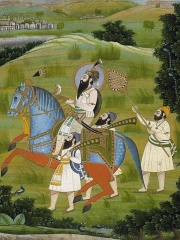
5. Guru Gobind Singh (1666 - 1708)
With an HPI of 66.37, Guru Gobind Singh is the 5th most famous Indian Religious Figure. His biography has been translated into 60 different languages.
Guru Gobind Singh (Punjabi pronunciation: [gʊɾuː goːbɪn̪d̪ᵊ sɪ́ŋgᵊ]; born Gobind Das; 22 December 1666 – 7 October 1708) was the tenth and last human Sikh Guru. He was a warrior, poet, and philosopher. In 1675, at the age of nine he was formally installed as the leader of the Sikhs after his father Guru Tegh Bahadur was executed by Emperor Aurangzeb. His father was the ninth Sikh Guru. His four biological sons died during his lifetime – two in battle and two executed by the Mughal governor Wazir Khan.Among his notable contributions to Sikhism are founding the Sikh warrior community called Khalsa in 1699 and introducing the Five Ks, the five articles of faith that Khalsa Sikhs wear at all times. Guru Gobind Singh is credited with the Dasam Granth whose hymns are a sacred part of Sikh prayers and Khalsa rituals. He is also credited as the one who finalized and enshrined the Guru Granth Sahib as Sikhism's primary holy religious scripture and the eternal Guru.

6. Mahākāśyapa (-550 - -549)
With an HPI of 65.46, Mahākāśyapa is the 6th most famous Indian Religious Figure. His biography has been translated into 32 different languages.
Mahākāśyapa (Pali: Mahākassapa) was one of the principal disciples of Gautama Buddha. He is regarded in Buddhism as an enlightened disciple, being foremost in ascetic practice. Mahākāśyapa assumed leadership of the monastic community following the parinirvāṇa (death) of the Buddha, presiding over the First Buddhist Council. He was considered to be the first patriarch in a number of Early Buddhist schools and continued to have an important role as patriarch in the Chan/Zen tradition. In Buddhist texts, he assumed many identities, that of a renunciant saint, a lawgiver, an anti-establishment figure, but also a "guarantor of future justice" in the time of Maitreya, the future Buddha—he has been described as "both the anchorite and the friend of mankind, even of the outcast".In canonical Buddhist texts in several traditions, Mahākāśyapa was born as Pippali in a village and entered an arranged marriage with a woman named Bhadra-Kapilānī. Both of them aspired to lead a celibate life, however, and they decided not to consummate their marriage. Having grown weary of the agricultural profession and the damage it did, they both left the lay life behind to become mendicants. Pippali later met the Buddha, under whom he was ordained as a monk, named Kāśyapa, but later called Mahākāśyapa to distinguish him from other disciples. Mahākāśyapa became an important disciple of the Buddha, to the extent that the Buddha exchanged his robe with him, which was a symbol of the transmittance of the Buddhist teaching. He became foremost in ascetic practices and attained enlightenment shortly after. He often had disputes with Ānanda, the attendant of the Buddha, due to their different dispositions and views. Despite his ascetic, strict and stern reputation, he paid an interest in community matters and teaching, and was known for his compassion for the poor, which sometimes caused him to be depicted as an anti-establishment figure. He had a prominent role in the cremation of the Buddha, acting as a sort of eldest son of the Buddha, as well as being the leader in the subsequent First Council. He is depicted as hesitatingly allowing Ānanda to participate in the council, and chastising him afterwards for a number of offenses the latter was regarded to have committed. Mahākāśyapa's life as described in the early Buddhist texts has been considerably studied by scholars, who have been skeptical about his role in the cremation, his role toward Ānanda and the historicity of the council itself. A number of scholars have hypothesized that the accounts have later been embellished to emphasize the values of the Buddhist establishment Mahākāśyapa stood for, emphasizing monastic discipline and ascetic values, as opposed to the values of Ānanda and other disciples. Regardless, it is clear that Mahākāśyapa had an important role in the early days of the Buddhist community after the Buddha's parinirvāṇa, to help establish a stable monastic tradition. He effectively became the leader for the first twenty years after the Buddha, as he had become the most influential figure in the monastic community. For this reason, he was regarded by many early Buddhist schools as a sort of first patriarch, and was seen to have started a lineage of patriarchs of Buddhism. In many post-canonical texts, Mahākāśyapa decided at the end of his life to enter a state of meditation and suspended animation, which was believed to cause his physical remains to stay intact in a cave under a mountain called Kukkuṭapāda, until the coming of Maitreya Buddha. This story has led to several cults and practices, and affected some Buddhist countries up until early modern times. It has been interpreted by scholars as a narrative to physically connect Gautama Buddha and Maitreya Buddha, through the body of Mahākāśyapa and Gautama Buddha's robe, which covered Mahākāśyapa's remains. In Chan Buddhism, this account was less emphasized, but Mahākāśyapa was seen to have received a special mind-to-mind transmission from Gautama Buddha outside of orthodox scripture, which became essential to the identity of Chan. Again, the robe was an important symbol in this transmission. Apart from having a role in texts and lineage, Mahākāśyapa has often been depicted in Buddhist art as a symbol of reassurance and hope for the future of Buddhism.

7. Chaitanya Mahaprabhu (1486 - 1534)
With an HPI of 65.30, Chaitanya Mahaprabhu is the 7th most famous Indian Religious Figure. His biography has been translated into 52 different languages.
Chaitanya Mahaprabhu (Sanskrit: श्री चैतन्य महाप्रभु, romanized: Caitanya Mahāprabhu), born Vishvambhar Mishra (Viśvambhara Miśra), was a 15th-century Indian Hindu saint from Bengal who was the founder of Gaudiya Vaishnavism, which considers him to be an incarnation of Krishna.Chaitanya Mahaprabhu's mode of worshipping Krishna with bhajan-kirtan and dance had a profound effect on Vaishnavism in Bengal. He was also the chief proponent of the Vedantic philosophy of Achintya Bheda Abheda Tattva. Mahaprabhu founded Gaudiya Vaishnavism (a.k.a. the Brahma-Madhva-Gaudiya Sampradaya). He expounded Bhakti yoga and popularised the chanting of the Hare Krishna Maha-mantra. He composed the Shikshashtakam (eight devotional prayers). Chaitanya is sometimes called Gauranga or Gaura due to his molten gold–like complexion. His birthday is celebrated as Gaura-purnima. He is also called Nimai because he was born underneath a Neem tree.

8. Maudgalyayana (-568 - -484)
With an HPI of 65.09, Maudgalyayana is the 8th most famous Indian Religious Figure. His biography has been translated into 36 different languages.
Maudgalyāyana (Pali: Moggallāna), also known as Mahāmaudgalyāyana or by his birth name Kolita, was one of the Buddha's closest disciples. Described as a contemporary of disciples such as Subhuti, Śāriputra (Pali: Sāriputta), and Mahākāśyapa (Pali: Mahākassapa), he is considered the second of the Buddha's two foremost male disciples, together with Śāriputra. Traditional accounts relate that Maudgalyāyana and Śāriputra become spiritual wanderers in their youth. After having searched for spiritual truth for a while, they come into contact with the Buddhist teaching through verses that have become widely known in the Buddhist world. Eventually they meet the Buddha himself and ordain as monks under him. Maudgalyāyana attains enlightenment shortly after that. Maudgalyayana and Śāriputra have a deep spiritual friendship. They are depicted in Buddhist art as the two disciples that accompany the Buddha, and they have complementing roles as teachers. As a teacher, Maudgalyayana is known for his psychic powers, and he is often depicted using these in his teaching methods. In many early Buddhist canons, Maudgalyāyana is instrumental in re-uniting the monastic community after Devadatta causes a schism. Furthermore, Maudgalyāyana is connected with accounts about the making of the first Buddha image. Maudgalyāyana dies at the age of eighty-four, killed through the efforts of a rival sect. This violent death is described in Buddhist scriptures as a result of Maudgalyāyana's karma of having killed his own parents in a previous life. Through post-canonical texts, Maudgalyāyana became known for his filial piety through a popular account of him transferring his merits to his mother. This led to a tradition in many Buddhist countries known as the ghost festival, during which people dedicate their merits to their ancestors. Maudgalyāyana has also traditionally been associated with meditation and sometimes Abhidharma texts, as well as the Dharmaguptaka school. In the nineteenth century, relics were found attributed to him, which have been widely venerated. His female counterpart was Utpalavarṇā (Pali: Uppalavaṇṇā).

9. Mirza Ghulam Ahmad (1835 - 1908)
With an HPI of 63.97, Mirza Ghulam Ahmad is the 9th most famous Indian Religious Figure. His biography has been translated into 46 different languages.
Mirza Ghulam Ahmad (13 February 1835 – 26 May 1908) was an Indian religious leader and the founder of the Ahmadiyya movement in Islam. He claimed to have been divinely appointed as the promised Messiah and Mahdī—which is the metaphorical second-coming of Jesus (mathīl-iʿIsā), in fulfillment of the Islamic prophecies regarding the end times, as well as the Mujaddid (centennial reviver) of the 14th Islamic century.Born to a family with aristocratic roots in Qadian, rural Punjab, Ahmad emerged as a writer and debater for Islam. When he was just over forty years of age, his father died and around that time he believed that God began to communicate with him. In 1889, he took a pledge of allegiance from forty of his supporters at Ludhiana and formed a community of followers upon what he claimed was divine instruction, stipulating ten conditions of initiation, an event that marks the establishment of the Ahmadiyya movement. The mission of the movement, according to him, was the reinstatement of the absolute oneness of God, the revival of Islam through the moral reformation of society along Islamic ideals, and the global propagation of Islam in its pristine form. As opposed to the Christian and mainstream Islamic view of Jesus (or Isa), being alive in heaven to return towards the end of time, Ahmad asserted that he had in fact survived crucifixion and died a natural death. He traveled extensively across the Punjab preaching his religious ideas and rallied support by combining a reformist programme with his personal revelations which he claimed to receive from God, attracting thereby substantial following within his lifetime as well as considerable hostility particularly from the Muslim Ulama. He is known to have engaged in numerous public debates and dialogues with Christian missionaries, Muslim scholars and Hindu revivalists. Ahmad was a prolific author and wrote more than ninety books on various religious, theological and moral subjects between the publication of the first volume of Barahin-i-Ahmadiyya (The Proofs of Ahmadiyya, his first major work) in 1880 and his death in May 1908. Many of his writings bear a polemical and apologetic tone in favour of Islam, seeking to establish its superiority as a religion through rational argumentation, often by articulating his own interpretations of Islamic teachings. He advocated a peaceful propagation of Islam and emphatically argued against the permissibility of military Jihad under circumstances prevailing in the present age. By the time of his death, he had gathered an estimated 400,000 followers, especially within the United Provinces, the Punjab and Sindh and had built a dynamic religious organisation with an executive body and its own printing press. After his death he was succeeded by his close companion Hakīm Noor-ud-Dīn who assumed the title of Khalīfatul Masīh (successor of the Messiah). Although Ahmad is revered by Ahmadi Muslims as the promised Messiah and Imām Mahdi, Muhammad nevertheless remains the central figure in Ahmadiyya Islam. Ahmad's claim to be a subordinate (ummati) prophet within Islam has remained a central point of controversy between his followers and mainstream Muslims, who believe Muhammad to be the last prophet.
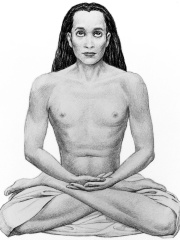
10. Mahavatar Babaji (b. 1900)
With an HPI of 63.42, Mahavatar Babaji is the 10th most famous Indian Religious Figure. His biography has been translated into 30 different languages.
Mahavatar Babaji (IAST: Mahāvatāra Bābājī; lit. 'Great Avatar (Revered) Father') is the Himalayan yogi and guru who taught Kriya Yoga to Lahiri Mahasaya (1828–1895). Babaji first became recognized through the writings of Paramahansa Yogananda, who devoted a chapter of his Autobiography of a Yogi to Babaji and founded Self-Realization Fellowship, a modern yoga movement that Babaji is associated with. The cave near Ranikhet where Babaji met Lahiri Mahasaya is now a tourist attraction and place of pilgrimage in India.: 170
People
Pantheon has 64 people classified as Indian religious figures born between 872 BC and 1996. Of these 64, 13 (20.31%) of them are still alive today. The most famous living Indian religious figures include Radha, Mahavatar Babaji, and Ravi Shankar. The most famous deceased Indian religious figures include Mahavira, Ānanda, and Sathya Sai Baba. As of April 2024, 4 new Indian religious figures have been added to Pantheon including Ashraf Ali Thanwi, Mohan Bhagwat, and Mirza Tahir Ahmad.
Living Indian Religious Figures
Go to all RankingsRadha
HPI: 66.83
Mahavatar Babaji
1900 - Present
HPI: 63.42
Ravi Shankar
1956 - Present
HPI: 61.33
Mata Amritanandamayi
1953 - Present
HPI: 61.11
George Alencherry
1945 - Present
HPI: 58.60
Zakir Naik
1965 - Present
HPI: 56.04
Mohan Bhagwat
1950 - Present
HPI: 49.59
Oswald Gracias
1944 - Present
HPI: 47.64
Joseph Coutts
1945 - Present
HPI: 46.59
Baselios Cleemis
1959 - Present
HPI: 41.88
Filipe Neri Ferrão
1953 - Present
HPI: 39.53
Bhuvneshwar Kumar
1990 - Present
HPI: 24.65
Deceased Indian Religious Figures
Go to all RankingsMahavira
599 BC - 527 BC
HPI: 75.34
Ānanda
600 BC - 500 BC
HPI: 74.61
Sathya Sai Baba
1926 - 2011
HPI: 70.05
Guru Gobind Singh
1666 - 1708
HPI: 66.37
Mahākāśyapa
550 BC - 549 BC
HPI: 65.46
Chaitanya Mahaprabhu
1486 - 1534
HPI: 65.30
Maudgalyayana
568 BC - 484 BC
HPI: 65.09
Mirza Ghulam Ahmad
1835 - 1908
HPI: 63.97
Sai Baba of Shirdi
1835 - 1918
HPI: 61.08
Dayananda Saraswati
1824 - 1883
HPI: 61.03
Maharishi Mahesh Yogi
1918 - 2008
HPI: 60.86
Ahmed Raza Khan Barelvi
1856 - 1921
HPI: 59.71
Newly Added Indian Religious Figures (2024)
Go to all RankingsAshraf Ali Thanwi
1863 - 1943
HPI: 53.02
Mohan Bhagwat
1950 - Present
HPI: 49.59
Mirza Tahir Ahmad
1928 - 2003
HPI: 46.14
Filipe Neri Ferrão
1953 - Present
HPI: 39.53
Overlapping Lives
Which Religious Figures were alive at the same time? This visualization shows the lifespans of the 25 most globally memorable Religious Figures since 1700.

